The normalization of antisemitism recently in the United States is extremely disturbing. The fact that this normalization is occurring among members of the Black community is also cause for concern. Unfortunately, the ebbs and flows of antisemitism are nothing new and Canada is far from immune to this issue. Contemporary and historical examples abound. Just before the pandemic took hold, I found myself increasingly concerned by this phenomenon. This is one of the reasons why, in January, 2020, I felt the need to write about Neil Carmichael’s antisemitic comic series from the early Canadian Silver age, The Story of Funny Money, and his ties to Canadian fascist movements.
In recent months we have witnessed NBA star Kyrie Irving promote antisemitism on social media, as well as Dave Chappelle hurling numerous hurtful jokes towards the Jewish community during his opening monologue on Saturday Night Live. Nowhere has the rampant attempt to normalize antisemitism become as inexcusable as during Kanye West’s recent publicity stunts with Donald Trump and Alex Jones. Kanye West is a Hitler apologist. It’s disgusting.
With all of this in mind, we recently announced that East Coast Toys and Games will no longer carry Kanye West albums or merchandise. Indeed, we quietly divested ourselves of this stuff a while back. I think we might have a couple of albums left that have a Kanye appearance on them, but we will not be restocking those either after we sell them.
These recent examples of antisemitism being promoted by a small segment of African American celebrities is part of a broader culture war that has been at the forefront of American politics for a number of years. This poisonous culture war has started to permeate Canadian politics and has moved away from the fringes of the alt-right into broad daylight. Even our small world of comics is not immune to this fringe normalization because of groups like Comicsgate.
Although I grew up in a non-religious household and am a staunch atheist, this situation is deeply personal to me. I have several close friends and family members who are either ethnically Jewish or practising Jews (or both) who should not have to put up with any of this. We also have many Jewish colleagues and clients across North America. This month’s edition of Forgotten Silver is for all of them.
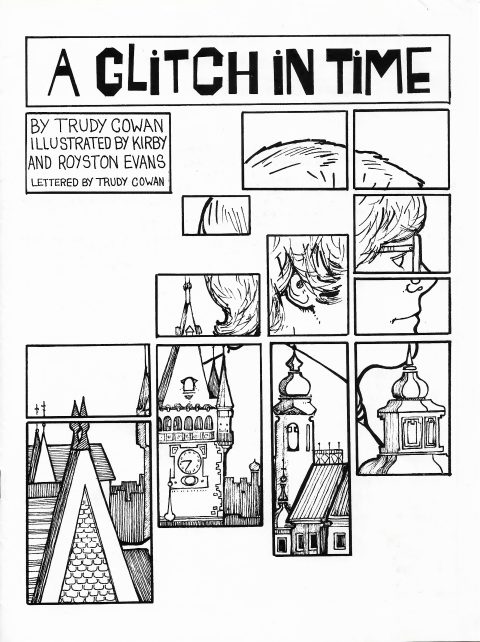
Cover of 1985’s A Glitch in Time by Trudy Cowan and Royston Evans. Image from my personal collection.
The only explicitly Jewish comic from the Canadian Silver Age that I have ever come across is 1985’s A Glitch in Time. This is also a rare example of a comic that was created in Alberta during the era. The comic was written by Trudy Cowan and illustrated by Royston Evans (with help from his son, Kirby Evans).
A Glitch in Time is an educational work that was produced in conjunction with Calgary’s Glenbow Museum. The comic was inspired by a children’s book called Joseph and Anna’s Time Capsule, which was released in 1984 by Summit Books and the Smithsonian Institution Traveling Exhibition Service (SITES). SITES exhibitions have long been the Smithsonian’s way to engage the broader museum system in the United States insofar as such exhibitions are designed to take place at museums that are often well off the beaten path (such as museums in rural areas). Ultimately, both A Glitch in Time and Joseph and Anna’s Time Capsule were linked to what is arguably the most important travelling Jewish Museum exhibit of the late 20th century.
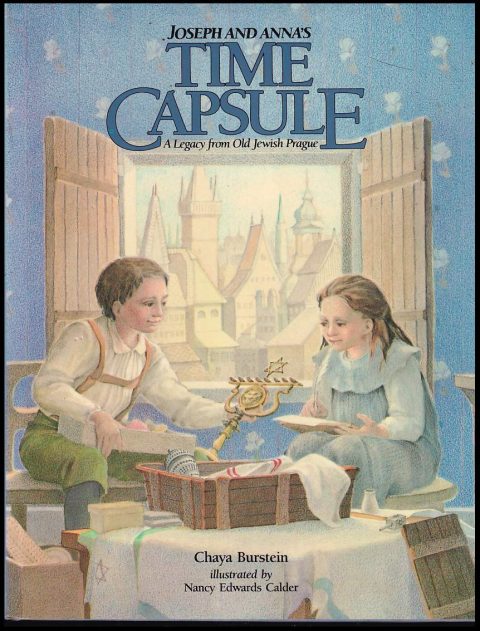
In 1980, the long-running exhibition The Precious Legacy: Judaic Treasures from the Czechoslovak State Collections debuted at the Whitworth Art Gallery in Manchester, U.K. The exhibit displayed and contextualized Jewish artifacts from then Czechoslovakia. The majority of these artifacts had been confiscated from Czechoslovakian Jews by Nazi Germany and were intended for the Nazi’s planned “Museum to an Extinct Race.” The artifacts became the property of the Jewish Museum in Prague after World War II. The majority of these objects dated from the 17th to mid-20th centuries and included silverwork, pottery, textiles, paintings, and drawings, as well as ritual and household items. Some of the items included in the exhibit were rarely seen outside of synagogues. The exhibit featured a mix of fine art, folk art and anthropological analysis and was so successful that it led to a world tour. Indeed, The Precious Legacy ran for almost twenty years in some capacity, only coming to an end in 1999.
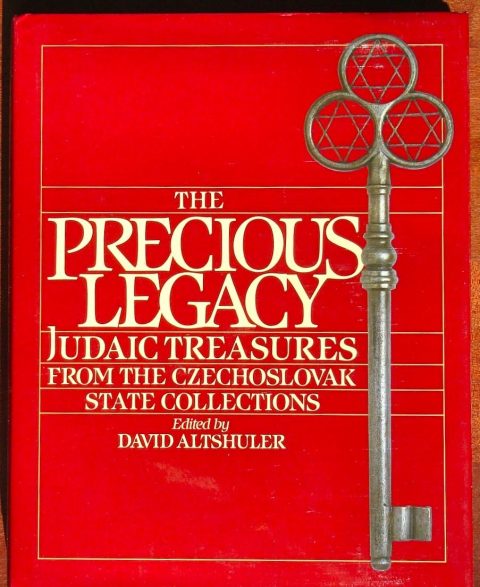
The history of this exhibit coming together is quite fascinating, as it involved museum exchanges during the height of the Cold War between geopolitical rivals. The director of the Whitworth Art Gallery, Charles Reginald Dodwell, spent eight years negotiating an exchange of exhibits, ultimately loaning a collection of pre-Raphaelite paintings that were shown in Bratislava and Prague prior to the Judaica collection being loaned to the Whitworth.
In the United States, congressional aide Mark E. Talisman had been trying to gain access to the collection for display since 1968, when he travelled to Prague as part of a mission of East-West cooperation. By the time the exhibit was open to the public in Manchester, Talisman had become chairman of Project Judaica and had gained government and corporate support to bring the exhibit to the USA. However, plans were complicated because the American government was storing Czech gold bullion in Fort Knox that the allies had appropriated in 1945. The Czechoslovakian government would not allow the exhibit to travel to the USA until the bullion was returned. This issue was resolved in 1982 and Talisman hired art historian Anna Cohn from the National Jewish Museum to take the reigns. She was subsequently appointed to the Smithsonian team and became the project director for the North American tour.
The Precious Legacy had its American debut at the Smithsonian on November 9, 1983, and ran for 53 days. The exhibit was so successful that a then record 110,000 visitors came to see it during its run. Beginning in 1984, the exhibit travelled across the USA under the auspices of SITES for nearly two years, before embarking on its Canadian tour in Toronto, Calgary, and Montreal. Afterwards, the collection returned to Prague before it was again on the move for the next decade and a half.

In Canada, the exhibit debuted on September 14, 1985, at the Royal Ontario Museum in Toronto due to the city being the home of one of the largest Czech Jewish expatriate communities in the world. The date also coincided with the beginning of Rosh Hashanah, one of the high holy days on the Jewish calendar that marks the beginning of the Jewish New Year. It was also the 40th anniversary of the end of World War II and the Holocaust.
Duncan Ferguson Cameron was the director of the Glenbow Museum in Calgary when he attended the opening of The Precious Legacy at the Smithsonian in 1983. He was so moved by the exhibit that he immediately initiated the idea for a Canadian tour. In 1984 he was named official negotiator on behalf of the National Museums of Canada. Cameron was able to secure the exhibit after Canada agreed to pay for transporting the artifacts back to Prague.
The exhibit ran at the Glenbow Museum from January 2 through March 9, 1986, and was an incredible success. It then ran from April through May 1986 in Montreal in order to coincide with Passover before returning to Czechoslovakia.
Trudy Cowan was born and raised in Toronto. She moved to Calgary when she was twenty-five years old in 1966. In 1969, Cowan was hired by the Glenbow Museum to head their educational programming. In 1975, she became curator of Fort Calgary. By the time that The Precious Legacy debuted at the Glenbow Museum, Cowan was just wrapping up a five-year term as the executive director of the Alberta Historical Resources Foundation. From 1988 until 2005, Cowan would become executive director of the Lougheed House Conservation Society. During the course of her career as a museum administrator, Cowan was also one of the founders of the Jewish Historical Society of Southern Alberta (JHSSA) and was vice-president and heritage advisor to The Little Synagogue on the Prairie project.
By the time Cowan wrote her only comic book, A Glitch in Time, she had already published several books using the name Trudy Soby (her then-husband’s last name) that focused on the history of Calgary, including A Walk Through Old Calgary and Be It Ever So Humble in 1975, Calgary, A Colorful History in 1977 and Fort Calgary in 1978. By the time she wrote A Glitch in Time, she was one of Calgary’s most established historians.
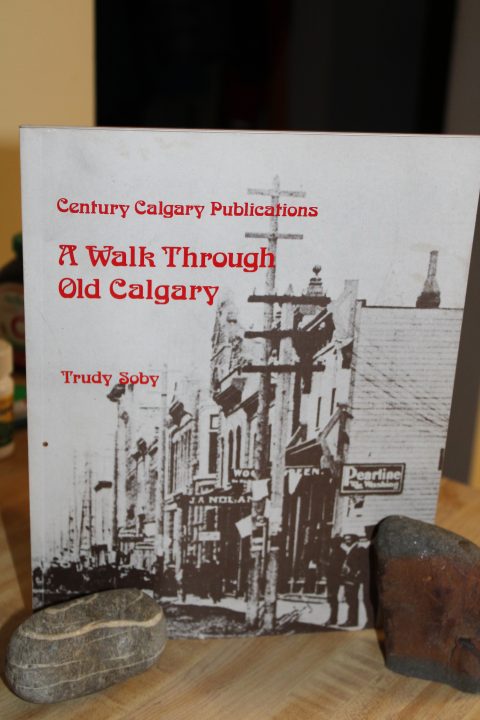
Cover of 1975’s A Walk Through Old Calgary by Trudy Soby. Image source from Abe Books.
As a key figure in researching and curator the stories of Jewish people in Alberta, Cowan was perfectly situated to write an educational comic for the Glenbow Museum’s exhibition of The Precious Legacy. Yet, she needed an artist.
Royston Evans was born in 1932 in a tenement building in London, England. As a child, he and his sister were among the many children who were evacuated from London during WWII. As a young man, he attended art college in London at the Regent Street Polytechnic (now the University of Westminster) and subsequently completed an advanced degree in Typographic design. In 1962, Evans married his wife, Lynne. They had two children, including a son named Kirby (who is credited as an artist on A Glitch in Time). After their children were born, the Evans family moved to the United States, bouncing between Detroit, Cleveland, Philadelphia, and Los Angeles as they chased work in commercial design. After Royston and Lynne divorced, he took a job in Calgary teaching graphic design and illustration at the Alberta College of Art and Design. Evans would find his footing in Calgary and would live in the city for twenty-two years. He even became professor emeritus in 1995.
Upon reaching adulthood, Kirby moved to Ottawa (where he still lives). The elder Evans eventually moved to Canada’s capital city to be close to his son’s family and grandchildren. He died in 2010.
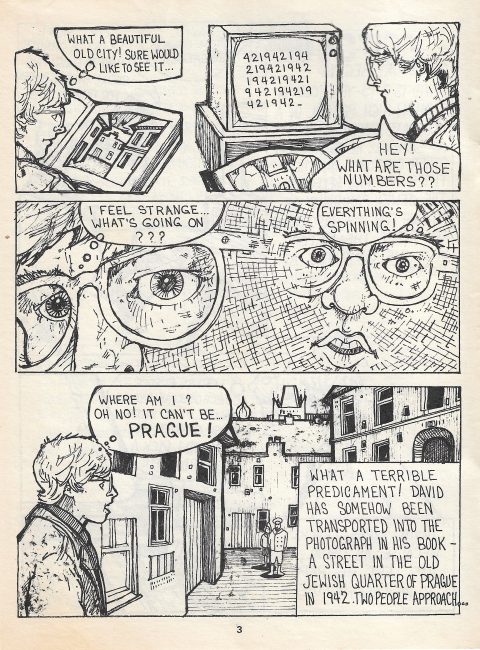
The comic follows a fifteen-year-old junior high student named David who is working on an essay about other cultures for one of his social studies classes and has decided to focus on the Jewish community of Prague for his report. As David types out his essay on his computer, the device goes haywire and, somehow, he finds himself transported to the Jewish quarter of Prague in 1942. David quickly meets two Jewish siblings named Morris and Lily. After taking Lily to her class, Morris proceeds to show David around Prague and teach him about Jewish culture.
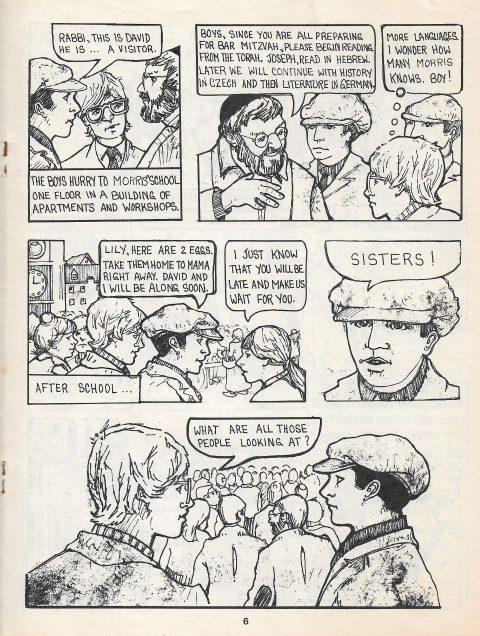
As part of this tour of the Jewish quarter, Morris takes David to a synagogue where he learns the Star of David and is invited to dinner by Morris’s father and grandfather to celebrate Hanukkah. Morris then takes David to his school where the boys meet the rabbi and David learns about the Bar Mitzvah and the Torah. All the while, David marvels at how the Jewish schoolchildren have to learn in Hebrew, Czech and German.
After school, the boys witness the adults fretting over a notice posted by the Nazis before heading to Morris’s home for dinner. Before they enter the home, David notices what he thinks is an unusual item placed on the door frame, which Morris explains is a Mezuzah. The boys subsequently join Morris’s family for dinner, where the adults explain to David the story of Hanukkah.
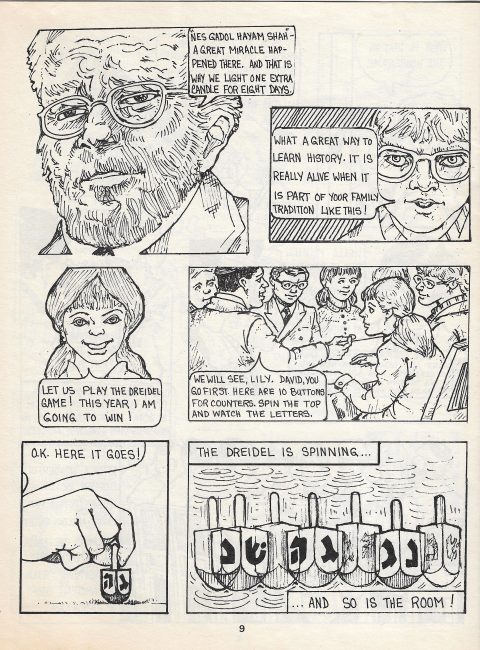
David plays the dreidel game with Lily after having dinner and learning about Hanukkah. Artwork by Royston Evans. Image from my personal collection.
After dinner, David plays the dreidel game with Lily. As the dreidel spins, David finds himself spinning as well and wakes up in front of his computer (which is still glitching out). He muses to himself that he must have learned more about Jewish history because of his essay than he originally thought before realizing that Lily’s dreidel is in his pocket as the story comes to an end.
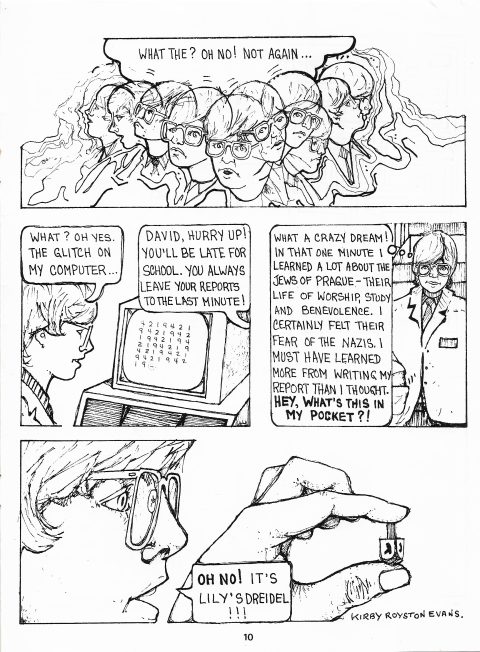
Ultimately, A Glitch in Time accomplishes what it sets out to do. It presents a fairly basic look at some parts of Judaism and Jewish symbolism, while also hinting at the horrors of the Holocaust and Nazi Germany that are brewing in the background of David and Morris’s story. In and of itself, it is a short, twelve-page comic book that works as part of a bigger project. As such, it is a worthy supplement to The Precious Legacy.
There are numerous examples of educational comics that were released during the Canadian Silver Age. I don’t cover them often, but they are an important part of the fabric of Canadian comics from this era, even if they aren’t the most popular collecting strain. A Glitch in Time is something of an oddity insofar as it was released in Alberta, was written by a museum administrator, and was drawn by a college professor. It is also the only explicitly Jewish comic from the entire era that I have ever come across.
A Glitch in Time is quite rare and I have never seen a copy come to market. I was fortunate to find the specimen that I own in a random long box that I purchased several years ago and I have not seen this comic anywhere online in the years since. However, I believe that the JHSSA may have a cache of these somewhere, as I found a short blip about Trudy Cowan and the comic in a newsletter from just over a decade ago that makes me think that the JHSSA still has copies available. If you are interested in sourcing one of these, that’s the only lead I can offer.
As 2022 comes to an end, I want to wish all of our Jewish friends, family members, colleagues, and clients a happy Hanukkah. For everyone else, I hope you have a great holiday, merry Christmas or even a short break to recharge your batteries as we approach the new year. I will see you all again in 2023.

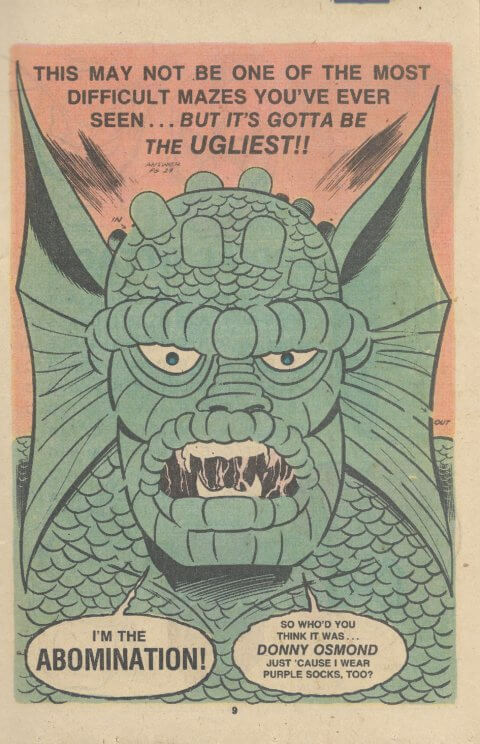
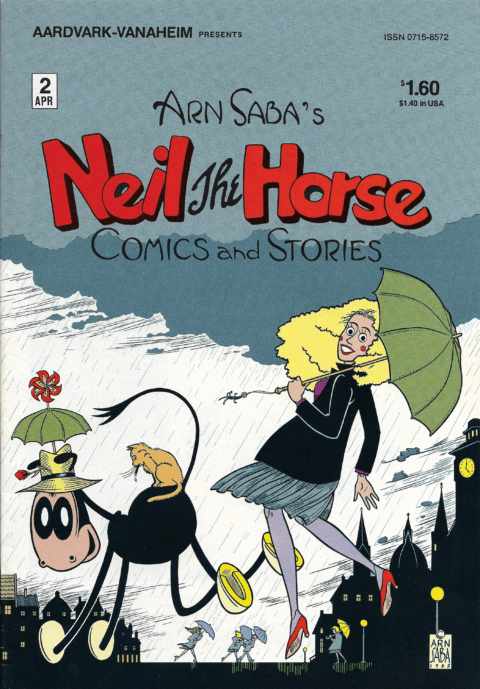
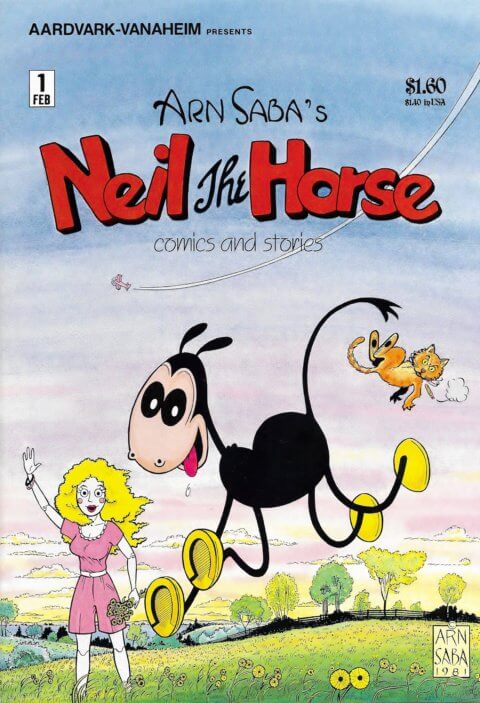
Thanks for putting that up. I could go on, almost endlessly. Steven Bergson and I put up an exhibit at the Beth Tzedec synogogue on Jews in comics– mostly Jewish creators but Jewish stories too. You can read a bit about it here. https://www.beth-tzedec.org/page/museum/a/display/s/1/item/zap-pow-oy-jews-and-the-comic-book-industry-7 One of my graphic novel The Tower of the Comic Book Freaks has a Jewish theme to it and you can read about it here. https://www.goodreads.com/en/book/show/32968262-the-tower-of-the-comic-book-freaks. My most recent graphic novel is about a holocaust survivor, living in a Jewish neighbourhood in Toronto in 1970, who gets sucked into a weird cult. You can’t read about it anywhere unless you wait a few months until it’s published.
Brian:
This is great work.
I and my wife do not know how we did not know of this comic at the time. We were next door in Saskatoon and Regina. I directing The Dunlop and Shari directing the WDM.
But we knew Trudy and Duncan really well. Closed a few bars and had many dinners. Certainly knew of Precious Legacy particularly during development stages. But a comic book by Trudy ?
However by 1984 Shari was back at National Musuem Corp. in Ottawa as it was winding down. She had been there at the beginning and I was at the Winnipeg Art Gallery. 1984-1985. until joining Shari 1985. So maybe part of the reason we missed it.
Still and all my network in popular culture was pretty deep and this just never came to my attention. I was working with some western curators on the popular culture of the RCMP at the time and still nothing about this comic. The RCMP were very early in the adventure comic strip. Don’t get me started.
So Thank You for your work. And I have to say as the year comes to the end that you and and Brock Silversides (local music history) have brightened my year as great writers/researchers on Canadian history.
Duncan Cameron was a bit of a mentor to us and in retirement revealed that he had done an exhibition of US comic strips at the ROM in the late 1950s. From their collections ! I did some work on it but did not produce anything being busy with other comic history projects.
Merry Christmas Brian (and to all on this site)
M.
Thanks for posting these links, Ron. I was not aware of the exhibit that you and Mr. Bergson held back in 2019. Of course, I have read “The Tower of Comic Book Freaks” and recommend it to everyone here. I just took a look at some of stuff you have been posting on Tumblr lately and my interest is piqued. I will definitely have to check out your new graphic novel after it comes out.
I probably should have mentioned in this month’s column is that there is a long history of Jewish comic creators in North America. Stuff like “A Glitch in Time” is only unusual in the Canadian context for the period from 1960-1990 that I write about because autobiographical or deeply personal comic stories were not yet in vogue. Of course, south of the border, Spiegelman was releasing “Maus” in serial form during the 1980s, but even this comic didn’t become famous until the early 1990s when it was released in graphic novel form.
Comics have changed a lot in the past couple of decades and the diversity of stories and storytelling techniques present today has only improved the format.
Ron, are there any current comics by Jewish creators or that are oriented towards Jewish audiences that you would recommend to Comic Book Daily readers?
Thanks for commenting, Wayne. It’s a pleasure to make your acquaintance. I am glad that you have been enjoying my monthly columns here at Comic Book Daily. I am not familiar with Brock Silversides, but will have to check out his work.
Given that you knew Trudy Cowan and Duncan Cameron back then and were part of the scene as director of the Dunlop Art Gallery at the time, it does seem strange that you didn’t come across “A Glitch in Time” when it was first released. That said, I suspect that this comic mostly slipped through the cracks when it was released through the Glenbow in 1985/1986. If you were in Ontario at the time it would have been easy to miss. Going further, I don’t think that Duncan Cameron had anything to do with this comic. It’s still weird that you hadn’t heard of this before now given your relationships with these two.
One of the things that I have come to appreciate as a pop culture researcher, as well as dealer and aficionado is that the well is deep (if not bottomless). I have been researching Canadian comics from a specific era for more than half a decade and I am still uncovering “new” titles from the era that were not on my master list. In fact, I recently learned of two comics from Newfoundland that were released in 1979 that I couldn’t believe that I had missed for so long given my strong connections to the comic scene here in Atlantic Canada.
I also consider myself to have a fairly broad knowledge of the history of Canadian film, but this year alone I have had the pleasure of watching several Canadian movies (thanks to Canadian International Pictures) that I was previously unaware of. I imagine that you had many “a-ha moments” during your career as a gallery director and curator. For me that’s part of the fun and helps to keep things interesting.
Thanks again for reaching out, Wayne. I hope that you and yours have a wonderful Christmas too!
P.S., I’d love to chat with you about the RCMP comic strips at some point, so please stay in touch.
I am reading this late. Very pertinent and informative. It’s disturbing how many people are believing anti-jewish propaganda.